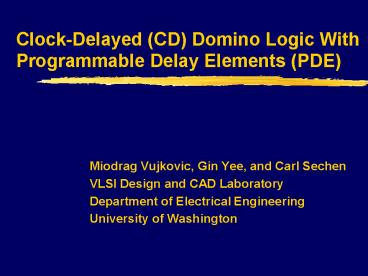ClockDelayed CD Domino Logic With Programmable Delay Elements PDE - PowerPoint PPT Presentation
1 / 17
Title:
ClockDelayed CD Domino Logic With Programmable Delay Elements PDE
Description:
Clock-Delayed (CD) Domino Logic With Programmable Delay Elements (PDE) ... Counter Enable Controller (CEC) each stage has OR gate and 2 D flip-flops ... – PowerPoint PPT presentation
Number of Views:68
Avg rating:3.0/5.0
Title: ClockDelayed CD Domino Logic With Programmable Delay Elements PDE
1
Clock-Delayed (CD) Domino Logic With Programmable
Delay Elements (PDE)
- Miodrag Vujkovic, Gin Yee, and Carl Sechen
- VLSI Design and CAD Laboratory
- Department of Electrical Engineering
- University of Washington
2
Non-inverting Gates
- Add transistor in parallel for OR - M circuits
and enable transistor to disable branch in normal
mode (enab 0) - Add the longest branch in parallel for AOI
circuits - All logical inputs at 0 (outputs
from the previous level
(i-1) in precharge) - clk(i) tied to transistor(s)
in additional
branch - transistor sizes chosen
to give worst-case
delay
from clk(i) to out
3
Inverting Gates
- No need to add additional transistors
- All logical inputs at 0 (outputs from the
previous level (i-1) in precharge) - Size (speed) of the
NAND gate is tuned
to the speed of the
nMOS dynamic gate - Worst-case delay
from clk(i) to out
4
Dual Gates
- Add transistor in parallel for and enable
transistor to disable branch in normal mode (enab
0) - both outputs (inverting and non-inverting) should
be scanned in separate cycles - for inverting outputs
enab 0 - for non-inverting
outputs
enab 1 - All logical inputs
at 0 (outputs
from the
previous level (i-1)
in precharge)
5
Programmable Delay Element (PDE)
- PDE consists of two stages
- - 6 conditional inverters in parallel
- - strong output driver
- PDE delay is determined by the input combination
bit5..0 - conditional inverters are geometrically sized
w(n) 2w(n-1) 2nw0 - output inverter can be sized according to the
load at i1 level
6
General Clocking Scheme
7
General Clocking Scheme (contd)
8
Tuning process
- the circuits are fully levelized
- additional circuitry for each gate level-
programmable delay element - - 6-bit counter
- - error circuit
- - clock enable gate clock tree
- - 1 stage of the counter enable controller
- delay elements are tuned level by level
- while level i is being tuned, levels 1 to i-1 are
in precharge phase (therefore level i inputs are
at 0) - only clk(i) and clk(i1) are enabled
9
Error Circuit
- pMOS dynamic circuit (NAND) is used instead of
nMOS - clock is taken from the input of the final
clock-tree stage of the level i1 - inputs to the pMOS transistors are the outputs
from gates at the level i - pMOS transistors
can be small
enough - error err(i) is latched
and used by Counter
Enable Controller - margin can be varied by
shifting clk(i1)
10
Error circuit (contd)
- For larger number of outputs at the gate level,
pMOS error detectors can be combined using nMOS
OR circuits - N pMOS
NAND - M
circuits - 1 nMOS
OR - N
circuit - Maximum number of
the sampled
outputs
equal to
NM
11
Error Circuit (contd)
- separated error circuits for
non-inverting and inverting
outputs - not needed for the levels
without dual gates (reduces
simulation time) - outputs of both polarities
are scanned in two
consecutive
cycles odd/even - error circuit may take only set of the worst-case
outputs (not all of them)
12
Error Circuit - Timing Diagrams
The worst-case output at the level i has to fully
evaluate before the evaluation phase of the clock
for the i1 level
Delays are not matched - error is detected
Delays are matched - no error
13
6-bit Binary Counter
- the binary counter generates input combination to
PDE (bit5..0) - delay is inversely proportional to the count
of the counter - when enab(i) becomes low the counter keeps
previous state - for levels with dual gates, the counter changes
its state every other cycle - minimum possible delay through PDE is determined
by the vector 1.11 ovfl 1 disables the
counter
14
Counter Enable Controller (CEC)
- each stage has OR
gate and 2 D
flip-flops - initially en signal
of the first stage is
set to 1 - en(i) is changed
at the falling edge
of the last level clk - detected error err(i) or count
overflow ovfl(i) disables the
level i
15
Counter/Controller - Timing Diagrams
fixed combination for the i level
16
Simulation results
- t481 MCNC benchmark is simulated
- 4 levels of logic, 3 PDEs, 3 counters
- needs approximately 100-150 cycles to tune itself
(for 100 MHz clock - about 1.5ms) - randomly generated capacitances at all gate
output nodes (can increase gate delay 50-75) - added capacitance simulates process and
environment variations that can increase gate
delay - goal verify the self-tuning process and look for
the margins (clock delay vs. worst-case gate
delay) - 10 different simulations performed
17
Simulation results
- margin ((clock_delay(i) - worst case
gate_delay(i)) / worst case gate_delay(i)) 100































